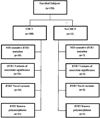Ryanodine receptor type 1 gene variants in the malignant hyperthermia-susceptible population of the United States
- PMID: 23558838
- PMCID: PMC3633164
- DOI: 10.1213/ANE.0b013e31828a71ff
Ryanodine receptor type 1 gene variants in the malignant hyperthermia-susceptible population of the United States
Abstract
Background: Mutations in the ryanodine receptor type 1 gene (RYR1) that encodes the skeletal muscle-specific intracellular calcium (Ca(2+)) release channel are a cause of malignant hyperthermia (MH). In this study, we examined RYR1 mutations in a large number of North American MH-susceptible (MHS) subjects without prior genetic diagnosis.
Methods: RYR1 was examined in 120 unrelated MHS subjects from the United States in a tiered manner. The α-1 subunit of the dihydropyridine receptor gene (CACNA1S) was screened for 4 variants in subjects in whom no abnormality was found in ≥ 100 exons of RYR1.
Results: Ten known causative MH mutations were found in 26 subjects. Variants of uncertain significance in RYR1 were found in 36 subjects, 16 of which are novel. Novel variants in both RYR1 and CACNA1S were found in the 1 subject who died of MH. Two RYR1 variants were found in 4 subjects. Variants of uncertain significance were found outside and inside the hotspots of RYR1. Maximal contractures in the caffeine-halothane contracture test were greater in those who had a known MH mutation or variant of uncertain significance in RYR1 than in those who did not.
Conclusions: The identification of novel RYR1 variants and previously observed RYR1 variants of uncertain significance in independent MHS families is necessary for demonstrating the significance of these variants for MH susceptibility and supports the need for functional studies of these variants. Continued reporting of the clinical phenotypes of MH is necessary for interpretation of genetic findings, especially because the pathogenicity of most of these genetic variants associated with MHS remains to be elucidated.
Figures

References
-
- Rueffert H, Olthoff D, Deutrich C, Meinecke CD, Froster UG. Mutation screening in the ryanodine receptor 1 gene (RYR1) in patients susceptible to malignant hyperthermia who show definite IVCT results: identification of three novel mutations. Acta Anaesthesiol Scand. 2002;46:692–698. - PubMed
-
- Monnier N, Kozak-Ribbens G, Krivosic-Horber R, Nivoche Y, Qi D, Kraev N, Loke J, Sharma P, Tegazzin V, Figarella-Branger D, Romero N, Mezin P, Bendahan D, Payen JF, Depret T, Maclennan DH, Lunardi J. Correlations between genotype and pharmacological, histological, functional, and clinical phenotypes in malignant hyperthermia susceptibility. Hum Mutat. 2005;26:413–425. - PubMed
-
- Sambuughin N, Holley H, Muldoon S, Brandom BW, de Bantel AM, Tobin JR, Nelson TE, Goldfarb LG. Screening of the entire ryanodine receptor type 1 coding region for sequence variants associated with malignant hyperthermia susceptibility in the North American population. Anesthesiology. 2005;102:515–521. - PubMed
-
- Ibarra MC, Wu S, Murayama K, Minami N, Ichihara Y, Kikuchi H, Noguchi S, Hayashi YK, Ochiai R, Nishino I. Malignant hyperthermia in Japan: mutation screening of the entire ryanodine receptor type 1 gene coding region by direct sequencing. Anesthesiology. 2006;104:1146–1154. - PubMed
-
- Levano S, Vukcevic M, Singer M, Matter A, Treves S, Urwyler A, Girard T. Increasing the number of diagnostic mutations in malignant hyperthermia. Hum Mutat. 2009;30:590–598. - PubMed
Publication types
MeSH terms
Substances
Grants and funding
LinkOut - more resources
Full Text Sources
Other Literature Sources
Molecular Biology Databases
Miscellaneous

